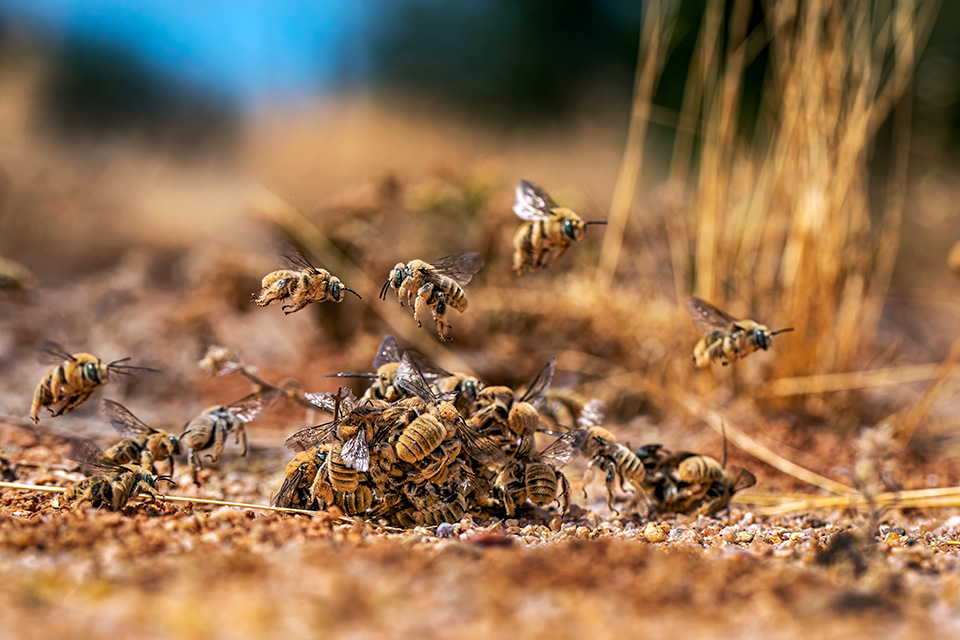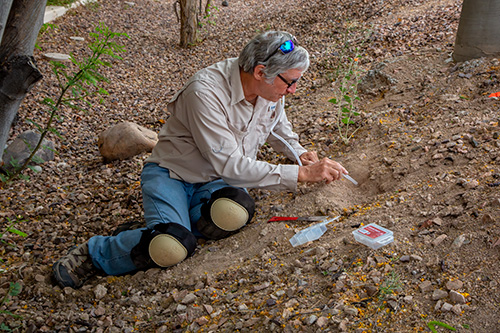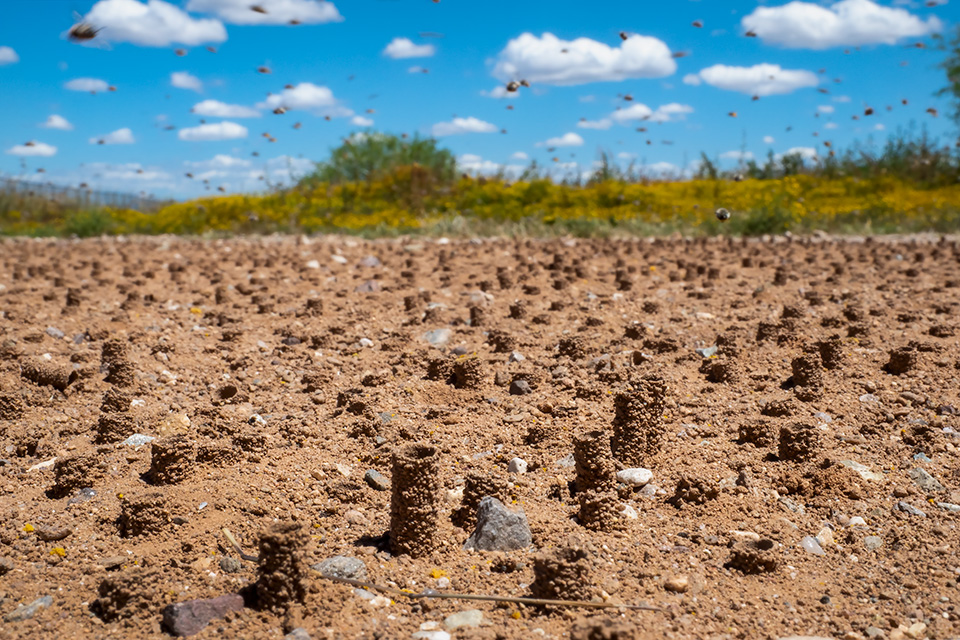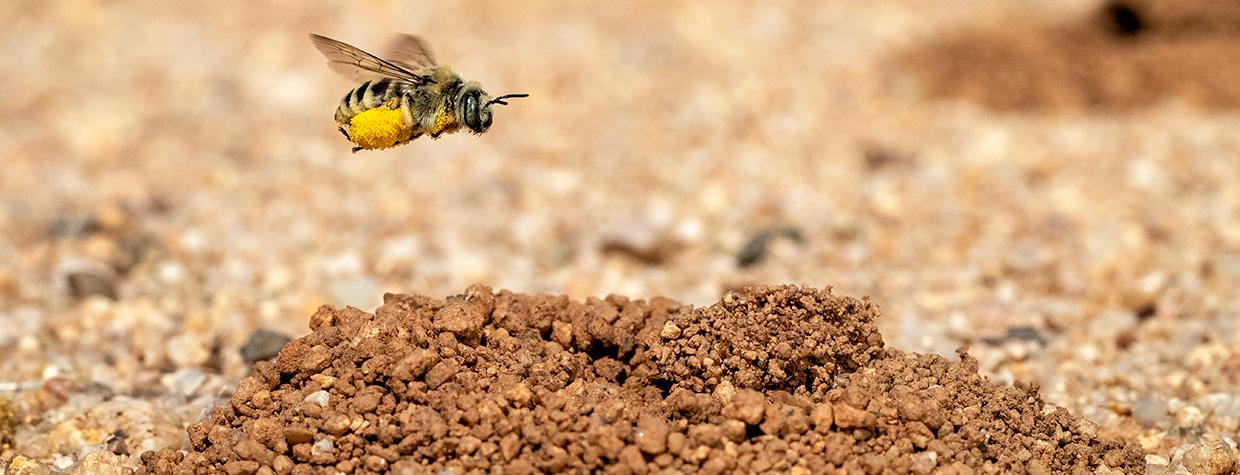Do bees dream? That’s something Tucson-based pollination ecologist Stephen Buchmann likes to ponder. After more than four decades studying bee biology, he’s learned the insects likely have a primitive form of consciousness and can store long-term memories while sleeping. So, why wouldn’t they also dream?
“Bees are self-aware; they’re sentient,” Buchmann writes in his new book, What a Bee Knows: Exploring the Thoughts, Memories and Personalities of Bees. “They solve problems and can think. … They discriminate between complex geometric shapes, even recognizing human faces. Bees can count, can use tools … and can learn to navigate mazes.”
European honeybees (Apis mellifera), the most familiar bee species to many people, are widely studied for their critical role in agriculture, but they aren’t the bees that captivate Buchmann. His life’s work is devoted to Arizona’s native bees, also called solitary bees. Unlike non-native honeybees, which exist in colonies populated by thousands of insects, Arizona’s solitary bees live alone, often in underground nests — and generally under the radar when it comes to interaction with humans.
The Sonoran Desert, with its well-drained soils and exceptional biodiversity, is a haven for solitary bees. Arizona is home to 1,043 different native bee species, more than anywhere else in the United States except California, where there are 1,514 species. And nearly half are “specialist bees,” which means they’ve evolved to pollinate or otherwise rely on a single genus or family of plants. Unique adaptations developed over millions of years have resulted in bee body parts that can extract oil from a specific flower, vibrate in a certain way to shake pollen loose and excrete a chemical compound that Buchmann describes as “rose-scented aftershave” to attract mates.
While European honeybees thrive through their uniformity and large colonies, solitary bees are the exact opposite: Their survival strategy revolves around specialization. The paloverde tree lives in a harmonious interdependence with Centris pallida, the prickly pear cactus with Diadasia rinconis, the globemallow with Diadasia diminuta and the sunflower with Dieunomia triangulifera, to name just a few of Arizona’s specialist bees.
Honeybees may be largely responsible for pollinating what Americans eat, but it’s the solitary bees that make the Sonoran Desert bloom. “Their lifestyles are incredible,” Buchmann says of his attraction to studying solitary bees. He’s authored almost 200 peer-reviewed papers and 10 books, often drawing from research conducted while lying on his belly in the desert, digging up bee nests. He’s also an adjunct professor at the University of Arizona, in both the Department of Entomology and the Department of Ecology and Evolutionary Biology.

Except to bee-obsessed scientists such as Buchmann, solitary bees exist largely out of view from humans, and threats to their livelihoods often go unnoticed. Over the past few decades, colony collapse disorder has been well documented among European honeybees in relation to agriculture, but perils exist for native bees, too. They include habitat loss due to the loss of food plants, pesticide use, drought and being outcompeted by Africanized honeybees.
“In the past, plants would be swarming with native bees,” Buchmann says of his frequent hikes around Southern Arizona, “and now I’ll see just a few.”
Buchmann and other scientists are on a mission to change that through education. They want people to know that each species has its own story, coloring and specially evolved body parts, along with
a surprising, soap-operatic element to the details of solitary bees’ various mating rituals. And all of it can be wiped away in an instant by a bulldozer or bottle of weed killer.
As Arizona’s urban areas keep growing and the climate keeps warming, the clock is ticking for these tiny creatures. The future of Arizona’s native bees may well depend on attracting many more prying eyes into their private lives to learn about what Buchmann describes as the species’ “innermost mysteries.”
Buchmann started studying bees as a teenager growing up in Orange County, California. He tended a honeybee hive in high school and once was stung more than 100 times while removing a colony from an abandoned shed. But his fascination with the insects continued. During college, he focused on researching ground-nesting bees, especially Centris pallida, also called the digger bee. After completing his Ph.D. at the University of California-Davis, he moved to the digger bee oasis of Tucson in 1979 and has been researching Sonoran Desert bees ever since.
“I like to think of ground-nesting solitary females as being like single moms with a family to feed,” Buchmann says. While European honeybee colonies have thousands of worker bees that collect pollen for the brood, a solitary female has to build her nest and bring home food all by herself. After mating in the spring, she’ll collect pollen, nectar and possibly floral oils from her specialized plants. Then, she’ll dig a tunnel with branches before using the nutrient-rich substances to sculpt an urn-shaped brood cell for each branch. Each brood cell includes enough pollen and nectar to support a single egg, and the female lays six to 10 eggs in a season before she dies without ever seeing her young.
“All the bees die off,” Buchmann says, “and the next generation that will carry the species forward is completely underground until the following spring or summer.” In the subsequent months, the larvae eat the pollen and nectar left for them before metamorphosing into a pupa, then into an adult bee.

Buchmann compares these ground-nesting bees to seeds because of the way they emerge from the earth in spring. And they know to dig their way out during the brief and variable period when their preferred food plants are blooming, presumably by getting the same temperature and environmental cues that annual or perennial wildflowers do. For example, if it’s been a dry winter and those plants are still dormant, the bees will stay underground until conditions are right.
Buchmann is especially fascinated by the mating adaptations of Centris pallida, which involve two types of males with completely different physiologies and mating strategies. In spring, the females dig upward from their brood cells, which usually are 4 to 8 inches underground, but wait just below the surface instead of fully emerging. Males that dug their way out days before fly around, searching for a female’s scent. One type of male, highly territorial and aggressive, digs up the female. “These big, bellicose males are like bodybuilders with parts for digging,” Buchmann says.
The problem for these bruisers is that multiple male bees will compete for the same female, and instead of mating, they often end up fighting. Meanwhile, the female flies away to the paloverde flower she’s been waiting her whole young life to visit. And this allows the second type of Centris pallida male to make his move. Unlike the bodybuilders, he is small, nimble and designed to look for stray females while others are duking it out.
Another unique mating strategy Buchmann has observed involves Xylocopa, a genus of large carpenter bees. He calls them “gentle giants” because they can be up to 1.5 inches long. In the afternoons, the male giants will exit their nests inside downed logs and fly to the top of a hill or ridge, where they gather to hover and impress females. In addition to this mating ritual, called lekking, the males secrete sex pheromones that contain the same chemical compounds found in roses.
“The females follow their noses uphill toward the males,” Buchmann says. “If the female likes a certain male, if his aftershave is just right, then she will let him hop on her back to mate. But if the male touches her before she’s ready, she flies away.”
Buchmann and colleague Robert Minckley have found that female carpenter bees can live for two to three years. The females will even stick around long enough to help care for their grandchildren. But the lives of most of Arizona’s native bees is far shorter. After waiting underground for a year or more, they emerge into a colorful explosion of life where their evolutionary destiny is typically fulfilled in just four or five weeks. And while just about anywhere in the wilds of Southern Arizona offers an excellent environment for a solitary bee to spend those few action-packed weeks, Minckley discovered one spot that’s an unmatched native bee paradise.
“There has always been talk about how many species of bees we have in Southern Arizona,” says Minckley, an entomologist and former graduate student of Buchmann’s who now teaches at the University of Rochester in New York. “I wanted to really pin things down regarding bee biodiversity in the region.”
During his post-doctoral research, Minckley had access to Southeastern Arizona’s San Bernardino National Wildlife Refuge, a former cattle ranch that had not been grazed in 50 years. He thought the pristine land would be an ideal site for a long-term survey of native bee species.
From 2000 to 2010, Minckley trapped thousands of bees at the refuge and on an adjoining piece of property across the border in Mexico. Once the specimens were sorted and categorized, the collection documented 500 different bee species in the survey area. This proved that the San Bernardino Valley had the most bee biodiversity on the planet — and because bees are a kind of keystone species, the finding also reflected the overall excellent health of the valley, which saw little development or agricultural pesticide use during the study period.
“The San Bernardino Valley is one of the great biogeographical regions in the world,” Minckley says. “It is right at the intersection of the Sonoran Desert and the Chihuahuan Desert. Different evolutionary histories all come together right there.”

Minckley recently donated his specimens — all 66,000 of them — to the UA Insect Collection, where they’ll be a resource for anyone who wants to learn more about the state’s many bee species.
“People get excited about native bees once they realize how unique they are,” says Wendy Moore, an associate professor of entomology at UA and the curator of the Insect Collection, which contains more than 2 million insect specimens. “Native bees are like apple pie. Everybody loves them.”
The Insect Collection, along with the Arizona-Sonora Desert Museum and Pima Community College, formed the Tucson Bee Collaborative in 2019 to study native bees and help educate the public about them. Its initiatives include collecting, sorting and identifying native bees in the region. The collaborative also educates the public about not using pesticides, installing bee-friendly landscaping and making backyard homes for solitary bee nests, and community scientists can get involved through the collaborative’s iNaturalist site.
Moore and other members of the collaborative hope that through better documentation and public awareness, keystone species such as native bees can be protected amid climate change and development pressures. “Bees are at least 120 million years old,” Moore says. “They have been co-evolving with the plants in our region for a very long time.”
There still are many things about native bees that scientists have yet to figure out, such as how bees underground are able to discern what’s happening with their food plants. Buchmann has observed that during periods of drought when plants aren’t flowering at all, the bees remain underground — sometimes for up to seven years — until survival conditions are right and the plants are flowering in abundance.
“If they were to come out too early or too late, they would starve,” Buchmann says. It’s another fascinating bee mystery that he likes to ponder. “Maybe there is some kind of underground chemical signaling going on between the plant roots and the bees so they can synchronize their emergence,” he adds.
And perhaps the bees are dreaming while they wait.

